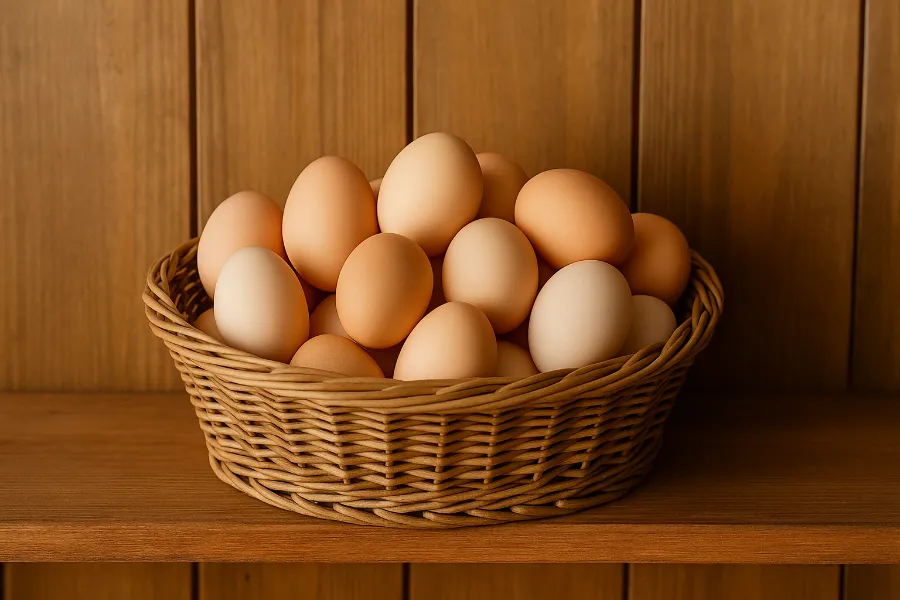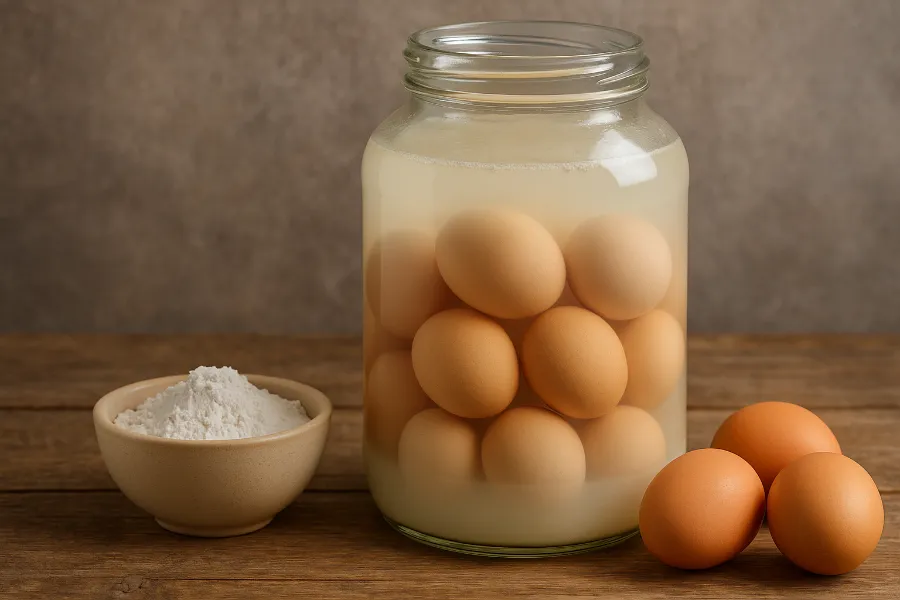I still remember the morning I walked out to the coop, gathered a dozen farm fresh eggs, and realized I couldn’t eat them all that day. That’s when my obsession with egg preservation began. I wanted to keep those golden yolks and firm whites intact far beyond the usual few days. Over the years, I’ve tested many old-school methods—some flops, some favorites—and settled into a handful of tried-and-true techniques. In this post, I’ll walk you through those approaches in a conversational, “come sit beside me” style. These are methods I’d use whether I had a fridge or not—because knowing your eggs will last even when the power’s out is empowering.
Let’s dive into methods for traditional preservation, using traditional methods egg storage that span everything from clay to ash to oil, all without electricity.
Farm fresh eggs

Before we talk about sealing, submerging, or coating, it all begins with how you collect your eggs. The fresher the egg, the better your chances at long-term success.
- Always collect eggs at least once or twice a day.
- Avoid washing them. The natural “bloom” or cuticle is your first line of defense. Washing removes that protective coating.
- If there’s dirt or droppings, gently brush them off with a dry cloth or soft brush—no soap or water until you’re ready to use them.
When you use true farm fresh eggs (that haven’t been washed), you give yourself a fighting chance with all the preservation methods that follow.
Traditional methods egg storage
Over the years, I’ve come to respect how inventive folks were before refrigeration existed. They worked with what they had—clay, lime, oil, ash, cool basements—and built systems that kept eggs safe and edible for weeks or months. The key principles that run through every method:
- Keep the eggs cool and protected from temperature swings.
- Prevent bacterial access by sealing or limiting pore exposure.
- Rotate and test for egg freshness as you go.
Let’s get into each method—how it works, how to do it, and what you can expect.
Clay sealing
One of my first experiments was clay sealing. It’s raw, messy, and low-tech, but if you have access to clay or clay soil, it’s worth knowing.
- Mix clay with just enough water to make a smooth, brushable slip—like thin paint.
- Dip each egg fully or brush the mixture on until the shell is coated.
- Allow them to dry thoroughly. The coating will harden and act as a barrier to air and bacteria.
- Store them in baskets or crocks in a cool, dry space (ideal: 50–60°F).
I got fairly good results: eggs could last 1–2 months with this method before showing signs of age. It’s not perfect, but for a quick, resource-light method, clay sealing is a respectable tool in your preservation toolkit.
Pantry storage
Sometimes the simplest method is the one you reach for first. Pantry storage is my go-to when I know I’ll use the eggs in just a few weeks.
- Keep eggs in a basket or crate on a cool, shaded shelf.
- Store them pointy-end down. This helps the yolk stay centered and discourages the air cell from drifting.
- Rotate the eggs—use the older ones first.
- Keep the location stable: avoid areas near stoves, sunlight, or heating vents.
In my experience, pantry storage will keep eggs good for 2–3 weeks, sometimes a little longer if your pantry is cool enough and doesn’t fluctuate. It’s the best no-fuss, no-additives method when you’ll eat them soon enough.

Limewater eggs
If you want truly long-term, limewater eggs are one of the most reliable traditional options. This is an old method that’s saved many a winter’s breakfast.
- Use slaked lime (calcium hydroxide).
- Dissolve it in water until saturated (there’s no more lime dissolving).
- Carefully place unwashed eggs, pointy ends down, into the mixture so they are fully submerged.
- Cover the container and keep it in a cool place.
The lime, being alkaline, helps seal the eggs’ pores and slows bacterial growth. With proper handling, I’ve seen eggs last 6–9 months, and some people claim up to a year. It’s one of the few methods I trust when I want eggs to outlast a season.
Ash storage
One of my favorite rustic tricks: ash storage. If you have a wood stove or fireplace, ash is likely a byproduct you already have, so this method doesn’t cost much.
- Collect fine, clean wood ash (no charcoal lumps).
- In a crock or barrel, layer eggs and sprinkle ash generously between each layer.
- Make sure eggs don’t touch one another.
- Store in a cool, dry place.
Ash helps keep oxygen away from the shells and regulates moisture. In my testing, eggs buried in ash held good for 6–8 months. It’s not glamorous, but it works—and it’s very forgiving.
Oiling eggs
When I had a handful of eggs I wanted to stretch for a few months, oiling eggs became a favorite. By coating the shell, you’re essentially restoring the function of the natural bloom.
- Use food-safe mineral oil or another oil that doesn’t go rancid (some people use lard or certain vegetable oils).
- Warm the oil slightly so it spreads easily.
- Dip or rub each egg until it has an even, thin coating.
- Store pointy-end down in a cool, dark place.
With oiled eggs, I’ve had success for 2–3 months, even sometimes longer if conditions stayed ideal (cool, dry). It’s a great middle ground between short-term pantry storage and ultra-long methods like limewater or ash.
Cellar storage
If your house has a basement, root cellar, or cool underground space, cellar storage can enhance any of the sealing methods above—or work on its own.
- The consistent temperatures below ground (often 50–55°F) are ideal for slowing spoilage.
- Use crates, crocks, or baskets, and line with straw or sawdust for cushioning and insulation.
- Keep eggs in a single layer or minimal stacking to avoid pressure and breakage.
- Combine with other methods: clay-coated eggs in the cellar last better; limewater or oil methods last even longer when stored below ground.
With just cellar storage (no sealing), eggs often last 2–3 months. Add a sealing method, and you push that further.
Egg freshness
No matter how carefully you preserve your eggs, you’ll always need methods to check if they’re still good. Here are my go-to tests:
- Float test: Drop an egg into water. If it sinks flat, it’s fresh. If one end lifts slightly, it’s older but usable. If it floats, it’s bad.
- Candle test: Use a flashlight or small candle behind the egg in a dark room. If the air space inside is tiny and yolk still holds, it’s good. If you see a large dark bubble or shifting structure, it’s past its prime.
- Sniff test: After cracking, if it gives a sulfurous or “off” smell, don’t risk it—discard.
I run these checks periodically—especially before baking or cooking something special.
Weaving methods together
In practice, in my own kitchen or homestead, I often combine these methods for best effect. For example:
- I might store some eggs in the pantry for immediate use.
- A batch I coat in oil goes into my cellar.
- The surplus I bury in ash or submerge in limewater for long-term.
- Clay sealing is useful when ash or lime isn’t readily available.
This layered approach gives me flexibility and confidence that I’ll always have usable eggs—even deep into winter.

A few cautions and tips
- Always start with top-quality, unwashed eggs. If an egg is cracked or heavily soiled, don’t preserve it.
- Clean all your containers, jars, crocks, and tools thoroughly before use.
- Label the date you preserved, and note which method you used (especially if you’re trying multiple methods at once).
- Keep your storage area cool, dark, and stable—avoid temperature fluctuations.
- Rotate your eggs: older ones first.
- Always run a freshness test before using any preserved egg in a dish.
Final thoughts
When I first stumbled into the world of egg preservation, I thought I’d settle on a single “best method.” After years of trial and error, though, I’ve come to see the beauty in having multiple techniques. Some are quick and simple (pantry storage), others are heavy-duty (limewater eggs or ash storage), and a few are resourceful backups (clay sealing or oiling).
If you’re trying to compete online with established blogs, one advantage you have is voice. Your readers will feel your experiments, your failures, and your successes. Tell them what worked (and what didn’t)—that makes the information richer and more trustworthy.
FAQs
Unwashed farm fresh eggs can last 2–3 weeks at room temperature, and even longer with methods like limewater or ash storage. Always test for freshness before using.
Limewater eggs are one of the most reliable, keeping eggs fresh for 6–9 months. Ash storage and oiling also work well depending on your resources.
No, washing removes the protective bloom that helps eggs last longer. Instead, gently brush off dirt and only wash right before use.
A thin coat of oil plugs the shell’s pores, reducing air and bacteria entry. Properly oiled eggs can last 2–3 months in a cool space.
Wood ash creates a low-oxygen environment that slows bacterial growth. With correct storage, eggs can remain good for up to 8 months.
Yes, cool and stable cellar temperatures naturally extend egg freshness to 2–3 months. Pairing with sealing methods like oil or limewater makes them last longer.
Use the float test: fresh eggs sink, older ones tilt, and bad ones float. The sniff test is the ultimate confirmation—if it smells off, don’t eat it.













